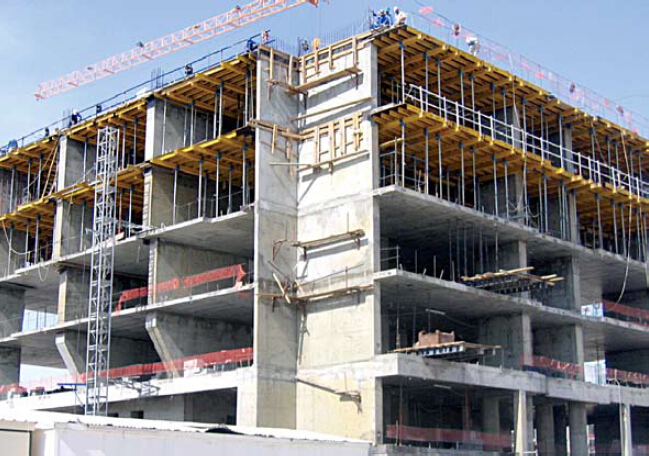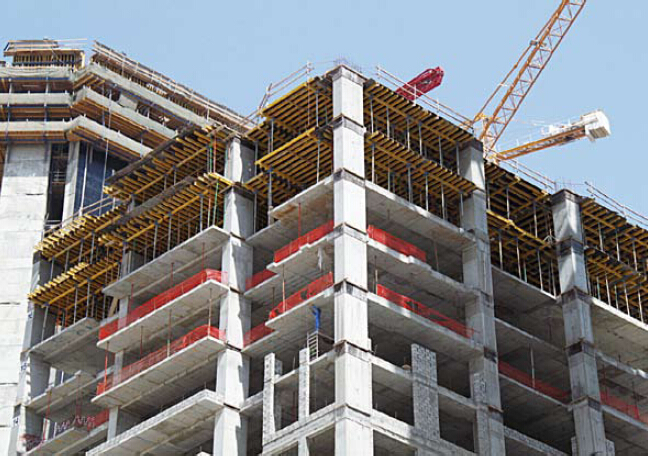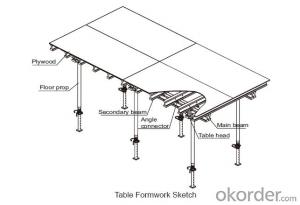Tabel Formwork System for Formwork and Scaffolding Build
- Loading Port:
- Tianjin
- Payment Terms:
- TT OR LC
- Min Order Qty:
- 50 m²
- Supply Capability:
- 1000 m²/month
OKorder Service Pledge
OKorder Financial Service
You Might Also Like
Product Specifications:
OKorder is offering high quality Building Scaffolding Table Formwork Systems at great prices with worldwide shipping. Table formwork is the most typical application, suitable for use with slabs or timber beam. Slab formwork is lightweight easy to erect and economical. Our supplier is a world-class manufacturer of scaffolding, and our products are utilized the world over, with OKorder annually supplying a full range of products to European, North American and Asian markets.
Product Applications:
Building Scaffolding Table Formwork Systems are for use in interior or exterior applications, and are designed to endure everyday use around a construction sites and remodeling projects.
Product Advantages:
OKorder's Building Scaffolding Table Formwork Systems help you get your project off the ground, with improved safety, economical construction and standardized parts.
Main Product Features:
· Improved safety with handrails
· Easy assembly
· Flexible structure, suitable for varied support systems
· Increases construction efficiency
· Formwork forklift and trolley compatible
· Flexible application with stand alone props
FAQ:
Q1: Why buy Materials & Equipment from OKorder.com?
A1: All products offered by OKorder.com are carefully selected from China's most reliable manufacturing enterprises. Through its ISO certifications, OKorder.com adheres to the highest standards and a commitment to supply chain safety and customer satisfaction.
Q2: How do we guarantee the quality of our products?
A2: We have established an advanced quality management system which conducts strict quality tests at every step, from raw materials to the final product. At the same time, we provide extensive follow-up service assurances as required.
Q3: What are the capacity requirements for all scaffolds?
A3: Each scaffold and scaffold component must support without failure its own weight and at least 4 times the maximum intended load applied or transmitted to it. Scaffolds and scaffold components must not be loaded in excess of their maximum intended loads or rated capacities, whichever is less. Load carrying timber members should be a minimum of 1,500 lb-f/in² construction grade lumber.
Q4: Should I use steel scaffolding or aluminum scaffold?
A4: If your job will run 6-8 weeks or more, steel scaffolding will actually be cheaper for you. Projects that run for a few hours to a few weeks are generally more practical and economical to do with aluminum scaffolding.
Q5: Is aluminum scaffold suitable for outdoor use?
A5: Aluminum scaffolding is designed to endure any weather conditions. It is tested to handle the cold winters of North America and Europe, and the extreme heats of Australia and Africa.
Q6: When should I order caster wheels versus leveling jacks?
A6: Order wheels for inside use. We do not recommend them outside unless on hard surface such as concrete or asphalt. Use level jacks outside or inside. Level jacks offer adjustability of the platform height of greater than 1500px.
Images:



- Q:What are the different types of steel formwork accessories available?
- Some common types of steel formwork accessories include form ties, formwork clamps, anchor bolts, formwork brackets, formwork connectors, and formwork spacers. These accessories are essential for ensuring the stability and proper alignment of the formwork system during concrete construction projects.
- Q:Is steel formwork easy to assemble and disassemble?
- Compared to other formwork systems, steel formwork offers a relatively simple assembly and disassembly process. By utilizing prefabricated panels, steel formwork can be easily connected and secured through various methods like clamps, pins, or wedges. These lightweight panels are also available in standardized sizes, ensuring convenient handling and transportation. Furthermore, steel formwork provides the advantage of adjustability and reusability. Adjustable screws or other mechanisms enable easy adaptation to different dimensions and shapes, granting flexibility in construction projects. Additionally, steel formwork can be utilized multiple times, significantly reducing the time and cost required for subsequent formwork installations. The disassembly process for steel formwork is also straightforward. Once the concrete has fully cured, the panels can be effortlessly removed by releasing the connecting mechanisms and dismantling the formwork system. Due to the lightweight nature of steel formwork panels, handling and removal are less labor-intensive compared to heavier materials like timber or plywood. In summary, the simplicity of assembly and disassembly makes steel formwork a highly favored choice for construction projects, particularly those that necessitate repetitive use and quick turnaround times.
- Q:Is steel formwork resistant to fire?
- Steel formwork is generally resistant to fire. Its high melting point and lack of easy ignition or contribution to fire spread make it suitable for construction projects that require fire-resistant materials. Steel formwork is designed and manufactured to withstand high temperatures without deformation or structural failure. This not only ensures its own fire resistance but also provides better fire protection for the concrete being poured into it, as concrete has inherent fire-resistant properties. However, the fire resistance of steel formwork may vary depending on factors such as steel thickness, formwork design, and fire protection measures at the construction site. It is recommended to consult professionals and adhere to fire safety regulations and guidelines when using steel formwork in construction projects.
- Q:Are there any specific design considerations for steel formwork?
- Yes, there are specific design considerations for steel formwork. These include factors such as the strength and stability of the steel structure, the weight-bearing capacity of the formwork, ease of assembly and disassembly, compatibility with different concrete mixtures, and the ability to withstand various site conditions such as weather and construction loads. Additionally, the design should also consider the reusability and durability of the steel formwork system to ensure cost-effectiveness and sustainability in construction projects.
- Q:How does steel formwork contribute to the quality of the concrete finish?
- Steel formwork plays a crucial role in ensuring the quality of the concrete finish. Firstly, steel formwork provides a strong and rigid framework that holds the concrete in place during the pouring and curing process. This prevents any movement or deformation of the concrete, resulting in a smooth and even finish. Additionally, steel formwork offers better dimensional stability compared to other types of formwork materials. It does not warp or distort under the pressure of the wet concrete, ensuring accurate and consistent shapes and dimensions. This is particularly important for structures that require precise measurements, such as beams, columns, or walls. Moreover, steel formwork allows for better control over the surface finish of the concrete. The smooth and non-absorbent surface of steel minimizes the risk of air bubbles or voids forming on the concrete surface. This results in a visually appealing finish with reduced imperfections. Furthermore, steel formwork provides excellent resistance to moisture and chemicals present in the concrete mix. This prevents the formwork from being damaged or deteriorated, ensuring a clean and unblemished concrete finish. It also allows for easy removal of the formwork once the concrete has cured, without leaving any residues or marks on the surface. Lastly, steel formwork can be reused multiple times, making it a cost-effective and sustainable choice. The ability to reuse the formwork ensures consistent quality in subsequent concrete pours, as the same set of formwork will provide the same level of support and accuracy. This eliminates the need for frequent investments in new formwork materials, reducing overall project costs and environmental impact. In conclusion, steel formwork significantly contributes to the quality of the concrete finish through its strength, dimensional stability, control over surface finish, resistance to moisture and chemicals, and reusability. Its use ensures a smooth, accurate, and visually appealing concrete surface while providing durability and cost-effectiveness to construction projects.
- Q:Can steel formwork be used for architectural construction projects?
- Indeed, architectural construction projects can utilize steel formwork. This versatile and durable construction material is commonly employed in architectural projects due to its numerous advantages. Steel formwork provides high strength, stability, and reusability. It can withstand high pressure and deliver a smooth and precise finish to concrete structures. Moreover, it is resistant to warping, bending, and shrinking, guaranteeing the structural integrity of the construction. Steel formwork is highly customizable, accommodating any shape or size, thus enabling architects to design unique and intricate structures. Thanks to its strength and durability, steel formwork can be reused multiple times, making it a cost-effective choice for construction projects. All in all, steel formwork is a dependable and efficient option for architectural construction endeavors.
- Q:What are the different quality control measures for steel formwork construction?
- Some of the different quality control measures for steel formwork construction include regular inspections of the formwork for any defects or damage, ensuring that the formwork is properly aligned and leveled, checking for proper reinforcement and tie spacing, and conducting load tests to ensure the formwork can withstand the required loads. Additionally, quality control measures may involve monitoring the concrete pouring process, checking for proper curing of the concrete, and conducting regular checks on the formwork for stability and safety.
- Q:How does steel formwork affect the overall constructability of a structure?
- The overall constructability of a structure can be significantly impacted by steel formwork. One of the main benefits of using steel formwork is its durability and strength. Steel is renowned for its high load-bearing capacity, enabling it to withstand the pressure exerted by fresh concrete during pouring and curing. This durability guarantees that the formwork remains stable and intact, minimizing the risk of collapse or deformation during construction. Another advantage of steel formwork is its reusability. Unlike traditional formwork materials like timber, steel can be utilized multiple times without compromising its structural integrity. This not only saves costs associated with purchasing new formwork for every construction project but also reduces waste and promotes sustainability. Steel formwork also provides flexibility and versatility in terms of design and construction requirements. It can be easily fabricated into various shapes and sizes, enabling the construction of intricate structures with detailed architectural elements. Steel formwork can be customized to suit specific project needs, facilitating efficient and precise construction. Furthermore, steel formwork delivers a smooth and uniform finish to the concrete surface. This eliminates the need for additional finishing work, such as plastering or sanding, thereby reducing construction time and costs. The smooth finish also enhances the aesthetic appeal of the structure, making it suitable for architectural projects where visual appeal is crucial. Moreover, steel formwork is recognized for its excellent dimensional stability. It resists warping, shrinking, or expanding due to moisture or temperature changes, ensuring accurate and consistent dimensions throughout the construction process. This dimensional stability contributes to the overall quality and precision of the structure. In conclusion, steel formwork has a positive impact on the overall constructability of a structure by offering durability, reusability, flexibility, a smooth finish, and dimensional stability. These advantages not only enhance construction efficiency and speed but also guarantee the structural integrity and aesthetic appeal of the final product.
- Q:How does steel formwork handle formwork stripping and cleaning?
- The durability and strength of steel formwork make it highly suitable for formwork stripping and cleaning processes. When it comes to removing the formwork, steel formwork can be easily disassembled and taken off the concrete structure without causing any damage. This is possible because steel is inherently rigid and stable, allowing for efficient and safe stripping. In addition, steel formwork is resistant to moisture, chemicals, and other environmental factors, which makes it easier to clean and maintain. Once the formwork is stripped, any concrete residue or debris can be easily cleaned off the steel surface using appropriate cleaning techniques. This may involve using high-pressure water jets, scrubbing, or other cleaning agents, depending on the specific requirements. Furthermore, steel formwork can be reused multiple times without significant deterioration. After cleaning, the formwork can be inspected for any damages or wear and tear. Any necessary repairs or replacements can be made to ensure the integrity of the formwork for future use. Overall, steel formwork is an efficient choice for handling formwork stripping and cleaning due to its durability, strength, and resistance to environmental factors. Its easy disassembly, cleaning capabilities, and reusability make it a preferred option for construction projects where regular formwork stripping and maintenance is required.
- Q:How does steel formwork contribute to the overall strength of the structure?
- Steel formwork contributes to the overall strength of a structure in multiple ways. Firstly, steel formwork provides a rigid framework that holds the concrete in place during the pouring and curing process. By ensuring that the concrete is properly contained and supported, steel formwork allows for the formation of a solid and uniform structure. Additionally, steel formwork helps in distributing the loads evenly across the structure. The steel panels and beams used in formwork are designed to withstand the pressure exerted by the wet concrete, ensuring that it is evenly distributed throughout the structure. This helps in preventing any weak spots or areas of uneven load distribution, ultimately enhancing the overall strength and stability of the structure. Furthermore, steel formwork provides reinforcement to the concrete. The steel panels and beams act as a reinforcement system, adding strength and durability to the structure. This reinforcement helps the structure withstand various external forces such as wind, earthquakes, and heavy loads, making it more robust and resistant to damage. Moreover, steel formwork allows for the creation of complex and intricate structures. Due to its high tensile strength and flexibility, steel can be easily shaped and molded into various forms, enabling the construction of unique and architecturally appealing designs. This versatility enhances the overall strength of the structure, as it can be tailored to withstand specific loads and forces. In summary, steel formwork contributes to the overall strength of a structure by providing a rigid framework, distributing loads evenly, reinforcing the concrete, and enabling the construction of complex designs. It plays a crucial role in ensuring that the structure is strong, durable, and capable of withstanding various external forces, making it a preferred choice in construction projects.
1. Manufacturer Overview |
|
|---|---|
| Location | |
| Year Established | |
| Annual Output Value | |
| Main Markets | |
| Company Certifications | |
2. Manufacturer Certificates |
|
|---|---|
| a) Certification Name | |
| Range | |
| Reference | |
| Validity Period | |
3. Manufacturer Capability |
|
|---|---|
| a)Trade Capacity | |
| Nearest Port | |
| Export Percentage | |
| No.of Employees in Trade Department | |
| Language Spoken: | |
| b)Factory Information | |
| Factory Size: | |
| No. of Production Lines | |
| Contract Manufacturing | |
| Product Price Range | |
Send your message to us
Tabel Formwork System for Formwork and Scaffolding Build
- Loading Port:
- Tianjin
- Payment Terms:
- TT OR LC
- Min Order Qty:
- 50 m²
- Supply Capability:
- 1000 m²/month
OKorder Service Pledge
OKorder Financial Service
Similar products
New products
Hot products
























